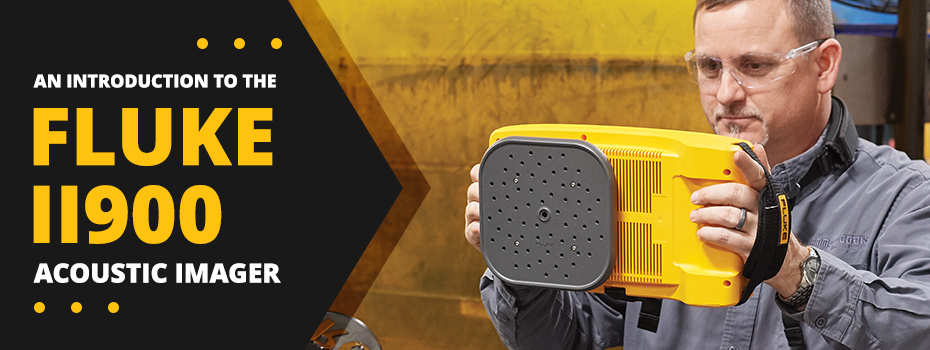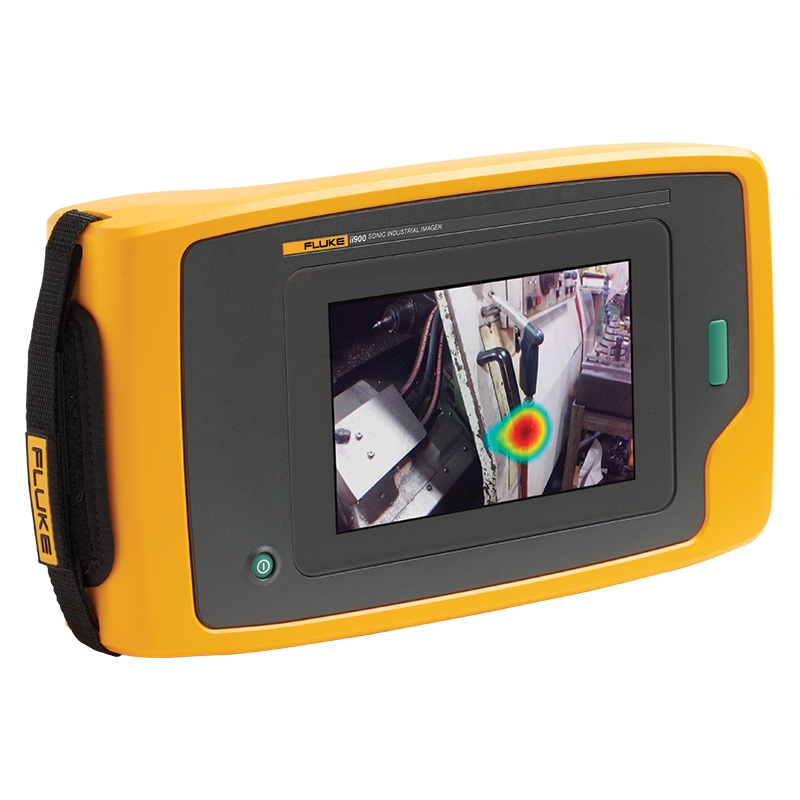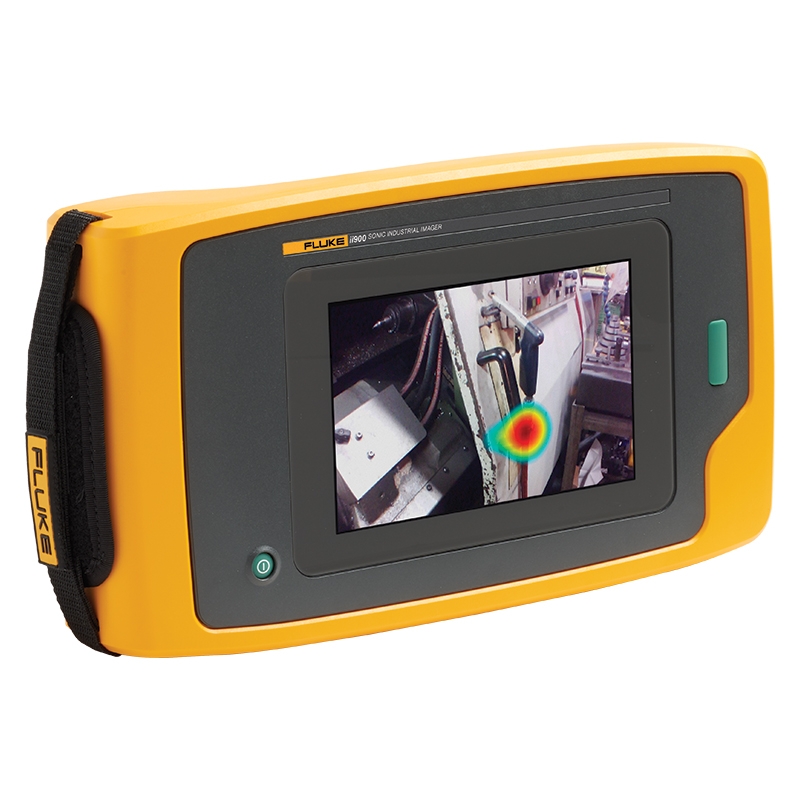
Fluke’s range of ii900 Acoustic Imagers, including the original ii900 and the upgraded ii910, have been specifically designed to ensure they are easy to use. With a simple one-button touchscreen interface, as well as clear acoustic imaging, operating the Fluke ii900 and ii910 Ultrasonic Cameras does not require specialist training. Thereby, allowing you to pinpoint leaks, mechanical failings, or partial discharge quickly. To this end, both models feature quantification modes, LeakQ, PDQ (ii910 only), and MecQ (ii910 only), intended to streamline and simplify analysis and reporting.
Quick Links
- What is Acoustic Imaging?
- Why is Acoustic Imaging Important?
- How do Quantification Modes Work?
- Which Fluke Acoustic Imager Is Right for You?
- Further Information
What is Acoustic Imaging?
Air leaks, potential discharge, and mechanical failings all disturb their surrounding atmospheres, generating ultrasonic sound. Fluke’s ii900 and ii910 Acoustic Imagers are fitted with an array of microphones. They are organised around a digital camera in a formation that optimises the detection of ultrasonic noise. Captured sound waves are subsequently converted into a sound map which is overlaid onto the corresponding digital image, enabling you to locate issues precisely, safely, and swiftly.
Why is Acoustic Imaging Important?
The US Department of Energy estimates that poorly maintained plants lose 20% of their compressed air capacity through leaks; while New Zealand’s government believes this to be higher at around 30-50%. Leaks can be an expensive drain on profits. They increase resource and energy consumption and may result in poor product quality leading to additional waste and, therefore, expensive disposal or recycling overheads. The US Department of Energy discovered that a single 1/8” (3mm) leak can cost companies upwards of $2500 a year (approximately £2060) if left untreated.[1]
Similarly, mechanical failings and partial discharge can hurt companies dearly. They may cause equipment to stop working, halt production, or deteriorate so severely that plants incur significant and expensive damage.
Ultrasonic imaging provides an easy, efficient, and effective method of monitoring plants for leaks, mechanical degradation, and partial discharge. Using an acoustic camera as part of a condition monitoring or predictive/preventative maintenance routine means you can find faults that cannot be seen or heard before catastrophic damage occurs. As a result, you can address leaks or faults at an earlier stage, potentially reducing losses and repair expenses. Moreover, acoustic imaging inspections can be conducted safely while equipment is running, decreasing downtime.
Need more convincing? Check out the case studies below detailing real-life situations in which Fluke’s Acoustic Cameras decreased costs and improved safety.
Fluke ii900 Acoustic Imager Case Study: Tyre Manufacturing
Fluke ii900 Acoustic Imager Case Study: Mediclinic
How Do Quantification Modes Work?
Quantification modes make your inspections even easier! They gather additional information and perform key analyses. Data is also stored, allowing you to conduct further analysis and/or create reports using Fluke’s free web-based software.
LeakQ Mode Overview
Pre-enabled on the Fluke ii900 and ii910 Acoustic Imagers, LeakQ mode quantifies and displays both the distance to and the size/rate of the air/gas leak. Text notes, photo notes, and/or tags may be added to images captured in LeakQ mode. These pictures can also be uploaded to Fluke’s web-based reporting software to determine the cost of the leak, i.e., the expense accrued due to the estimated price and rate of wasted resources. As a result, you can quickly assess which leaks are the most severe, prioritising repairs based on which are affecting overheads, and therefore profits, the most.
PDQ Mode Overview
Unique to the Fluke ii910 Ultrasonic Imager, PDQ mode calculates the distance to partial discharge and classifies the type of partial discharge detected. Images taken in this mode can also be saved with text, photo, and tag notes and may be uploaded to Fluke’s online software for the creation of reports.
MecQ Mode Overview
Only available on the Fluke ii910 Acoustic Camera, MecQ mode is a mechanical scanning function that allows you to pinpoint mechanical failings, such as bearings wear, from a safe distance. It identifies specific areas with mechanical problems quickly and easily. To this end, MecQ mode offers three sub-modes:
- 30Hz
- User-selectable (2-100kHz)
- Fixed Multi-Mode (15, 20, 30, 40, 60 kHz)
Which Fluke Acoustic Imager is Right for You?
Offering different frequency ranges, detection distances, and quantification modes, Fluke’s ii900 and ii910 are optimised for slightly different applications.
Fluke ii900 Acoustic Imager
Featuring a 2kHz to 52kHz frequency range, 50m detection distance, and LeakQ mode, the Fluke ii900 Acoustic Camera is specifically designed for detecting leaks in compressed air, gas, steam, and vacuum systems.
Buy the Fluke ii900 Ultrasonic Imager
Fluke ii910 Acoustic Imager
Like the Fluke ii900, the Fluke ii910 Acoustic Camera features a LeakQ mode enabling the locating of leaks in compressed air, gas, steam, and vacuum systems. However, with an extended frequency range (2kHz to 100KHz); greater 120m detection distance; and additional PDQ and MecQ modes, the Fluke ii910 Ultrasonic Imager can also:
- Pinpoint partial discharge in power distribution systems and high-voltage equipment
- Find mechanical failings
Buy the Fluke ii900 Acoustic Camera
Fluke ii900 & ii910 Acoustic Camera Comparison
- Frequency Range: 2kHz - 52kHz
- Detection Distance: 50m
- LeakQ mode
- 7" LCD touchscreen display
- SoundSight technology
- Multiple microphones
- Improves user safety
- Efficiently inspect an entire plant
- Easy to use
- Carry out inspections during peak operating times
- Detect leaks in compressed air, gas, steam, and vacuum systems
- Frequency Range: 2kHz - 100kHz
- Detection Distance: 120m
- LeakQ, PDQ, and MecQ modes
- 7" LCD touchscreen display
- SoundSight technology
- Multiple microphones
- Improves user safety
- Efficiently inspect an entire plant
- Easy to use
- Carry out inspections during peak operating times
- Detect leaks, partial discharge, and mechanical failings
Further Information
For additional details regarding the Fluke ii900 and ii910 Acoustic Imagers, please contact our Sales team on 01642 931 329 or via our online form.
Alternatively, you can browse our extensive range of Fluke products below.
[1] Fluke, Hidden profits found in quick detection of compressed air, gas and vacuum leaks, last accessed 06 October 2023




